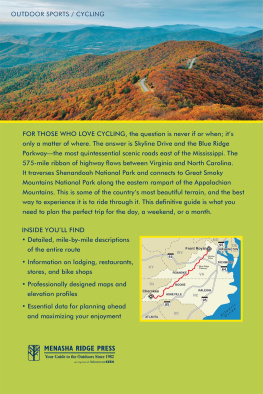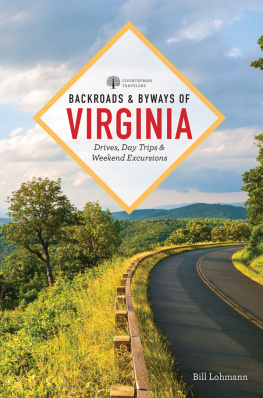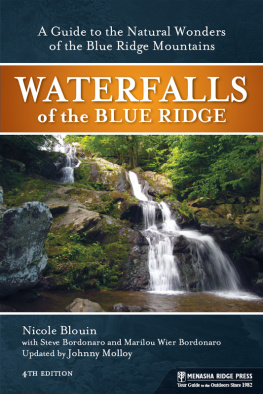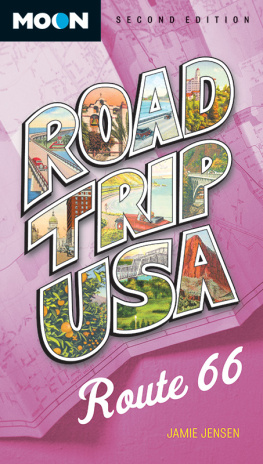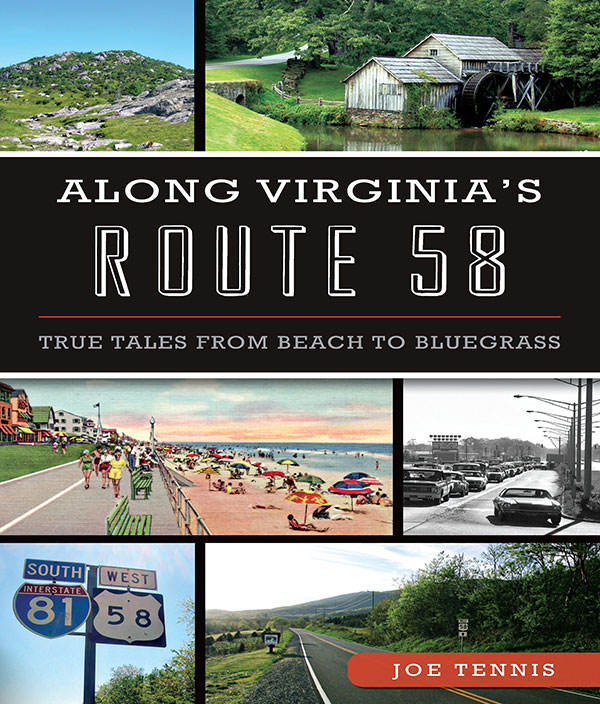

Published by The History Press
Charleston, SC
www.historypress.net
Copyright 2015 by Joe Tennis
All rights reserved
Front cover, top left : Wilburn Ridge, along the Appalachian Trail. Author photo ; top right : Mabry Mill in Floyd County, just off the Blue Ridge Parkway. Author photo ; center left : A 1940s-era postcard depicts the Virginia Beach Boardwalk. Authors collection ; center right : A 1972 photograph shows traffic on U.S. 58/Virginia Beach Boulevard, with Pembroke Mall, at left, in Virginia Beach. Courtesy Virginia Department of Transportation ; lower left : U.S. 58 overlaps I-81 in Washington County, between Bristol and Abingdon. Author photo ; lower right : U.S. 58 curves just below the peak of Whitetop Mountain. Author photo .
All color photographs by Joe Tennis.
First published 2015
e-book edition 2015
ISBN 978.1.62585.616.6
Library of Congress Control Number: 2015945704
print edition ISBN 978.1.46711.884.2
Notice : The information in this book is true and complete to the best of our knowledge. It is offered without guarantee on the part of the author or The History Press. The author and The History Press disclaim all liability in connection with the use of this book.
All rights reserved. No part of this book may be reproduced or transmitted in any form whatsoever without prior written permission from the publisher except in the case of brief quotations embodied in critical articles and reviews.
A previous edition of this book was published as Beach to Bluegrass: Places to Brake on Virginias Longest Road in 2007.
This work is based on the best references available at the time of research. The author and publisher assume no liabilities arising from use of this book or its contents. This work does not give anyone the right to trespass on properties that may be noted as drive-by attractions/curiosities or those that can be seen from a public road, trail or streambed. All personal property rights should be respected.
For my son, John Patrick

U.S. 58 spans more than five hundred miles from Virginia Beach to Cumberland Gap National Historical Park, making it the longest road in Virginia. Courtesy Virginia Tourism Corporation .
CONTENTS
ACKNOWLEDGEMENTS
Special thanks for help in this project to J. Banks Smither, Darcy Mahan, Daniel Rodgers, Lois Stickles, Jennifer Hurst-Wender, Carlos Wilson, Harold Barkley, Mike West, Colonel William J. Davis, Liona Bourgeault, Albert Joynes, Deloras Freeman, Robin K. Rountree, Lee King, Connie Henderson, Dave Sadowski, Frank Malone, Jack Hite, Elaine Bowers, Scott Shanklin, Justin Kerns, Mary Page Richardson, Robert Benning, Ed and Carol Brown, J.C. Eldreth, James Sheppard, Wyatt Barczak, Julie Allen, John Reynolds, Beth Ford, Ellen Brown, David Sheley, Tim Cable, Tom Perry, John Grooms, Henry Ayers, Ella Sue Joyce, Sharoll Shumate, Felecia Shelor, Coy Lee Yeatts, Ann Vaughn, Ronald W. Hall, Joe Wilson, Nancy Riggins, Paul Dellinger, Shirley Gordon, Bob McKinney, Emily Spencer, David and Nerine Thomas, Jaye and Joan Baldwin, Jack and Rubinette Niemann, Hendrika Schuster, Eleanor Grasselli, Charlie Moore, Skip Blackburn, Lawrence Dye, Bob McCracken, Pete Sheffey, Bill McKee, Donnamarie Emmert, Raven Marin, Melissa Watson, Carol Hawthorne-Taylor, Kimberly Roberts, Howard Fergus, Ben Jennings, Mary Dudley Porterfield, Richard Rose, Debbie Addison, Kathleen Bundy, Eleanor Walker Jones, Robert Weisfeld, William Booker, Anne West, Tim Buchanan, Steve and Kim Rhodes, Darlene Cole, Rita Forrester, Fern Carter Salyer, Tim White, Rex and Lisa McCarty, Kenny Fannon, June Presley, Bob and Suzy Harrison, Frank Kilgore, Jean Kilgore, Lucille Cowden Necessary, Jerry Ivey, Craig Seaver, Tony Scales, Jerry Cox, Judy Davidson, Rebecca Jones, Robert Estes, Robert Monroe, Rhonda Robertson, Billy Heck, Michael Brindle, Carol Borneman, Martha Wiley, Scott Teodorski, Steve Galyean, Marc Brodsky, Jennifer McDaid, Jennifer Wampler, Jennifer Bauer, the staff of the Washington County Public Library in Abingdon, the Peanut Patch at Courtland, Lisa Johnson and Food City, the Crooked Road and all fans of Beach to Bluegrass.
More help, advice, encouragement and support came from fellow authors, writers, editors and historians: V.N. Bud Phillips, David McGee, Linda Hoagland, Carol Jackson, Keith Bartlett, Jim Campbell, Cara Ellen Modisett, Kurt Rheinheimer, Theresa Lewis, Sherry Lewis, Jan Patrick, George Stone, Erin Parkhurst, Melissa M. Stewart, Angela Blue, Betsy DiJulio, Phyllis Speidell, Tracy Agnew, Gloria Oster, Tom Netherland, Stephanie Porter-Nichols, Lisa Clary, Mark Sage and May-Lily Lee.
Sincere appreciation also to family members: Maggie Caudill; James and Melissa Caudill; Rob and Michelle Tennis; Ben Tennis; Pat and Angie Wolfe; Thomas Wolfe; Amber Wolfe; Ralph Boswell; Steve and Stephanie Talbert; Dr. Walter Wolfe; John Wolfe; Homer Wolfe; my parents, Richard and Jeanette Tennis; my wife, Mary; and most especially my daughter, Abigail, for traveling the highways and constantly cheering 58! and Beach to Bluegrass!
Introduction
TRAIL OF TALES
In the early days of the American colonies, going beyond the Appalachian Mountains to the bluegrass of Kentucky would mirror how the Jamestown settlers sailed the Atlantic Ocean to reach the beach of Virginia. The journey to either destination was filled with mystery and confrontation.
Along Virginias Route 58: True Tales from Beach to Bluegrass links these journeys with its own. From Cape Henry to the Cumberland Gap, tales of triumph and tragedy lie sandwiched between Cape Henrys Gateway to the New World and Cumberland Gaps Gateway to the West.
The fifty-eight-chapter story lies largely along U.S. 58, Virginias longest road. This east-to-west highway spans more than five hundred miles and passes through every type of town and terrain imaginable in the Old Dominion, from the traffic-tied Tidewater to the pastoral piedmont, the lofty Blue Ridge to the once-perilous Powell Valley, lying as far west as Detroit.
Varied in its journey, U.S. 58 ranges from ten lanes in urban Virginia Beach to two-lane sprints that are as serpentine as streams near Creek Junction. Connecting communities just above the borders of North Carolina and Tennessee, U.S. 58 once held the distinction of being the longest U.S. highway to be contained within one state. But in 1996, a tunnel opened near Cumberland Gap on U.S. 25E, and that shifted the westernmost stretch of U.S. 58 southward, for about a half mile, into Tennessee.
Still, Virginians like to think of this as their road. It is, after all, the longest numbered highway in the Old Dominion.
During the Great Depression of the 1930s, U.S. 58 was established on the former paths of state highways 10 and 12. It connected the main streets of textiles towns in southern Virginia. Since 1989, much of this route has changed considerably. Some scary sectionslike Suicide Strip, a two-lane portion between Suffolk and Emporiaare now just bad memories. Yet some portions remain as two lanes and still await improvement while many miles are upgraded to become a four-lane superhighway as part of the Virginia Department of Transportations U.S. Route 58 Corridor Development Program.


